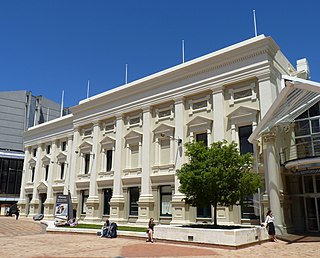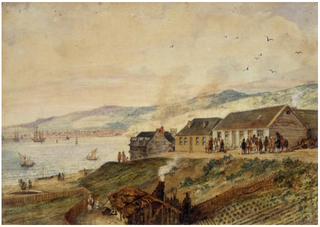
TheArts Centre Te Matatiki Toi Ora is a hub for arts, culture, education, creativity and entrepreneurship in Christchurch, New Zealand. It is located in the Gothic Revival former Canterbury College, Christchurch Boys' High School and Christchurch Girls' High School buildings, many of which were designed by Benjamin Mountfort. The centre is a national landmark and taonga as it is home to New Zealand's largest collection of category one heritage buildings with 21 of the 23 buildings covered by Heritage New Zealand listings.

Te Aro is an inner-city suburb of Wellington, New Zealand. It comprises the southern part of the central business district including the majority of the city's entertainment district and covers the mostly flat area of city between The Terrace and Cambridge Terrace at the base of Mount Victoria.

The Hotel St. George was once one of Wellington, New Zealand's top hotels and a prominent building.

The National War Memorial of New Zealand is located next to the Dominion Museum building on Buckle Street, in Wellington, the nation's capital. The war memorial was dedicated in 1932 on Anzac Day in commemoration of the First World War. It also officially remembers the New Zealanders who gave their lives in the South African War, World War II and the wars in Korea, Malaysia and Vietnam.

The St. James Theatre is a large proscenium stage theatre in central Wellington and home to the Royal New Zealand Ballet. The building was designed in 1912 by New Zealand-born theatre designer Henry Eli White. It is located on Courtenay Place, the main street of Wellington's entertainment district, opposite the Reading Cinema complex.

The Majestic Centre, designed by Jack Manning of Manning Mitchell in association with Kendon McGrail of Jasmax Architects, was completed in 1991. The main building of the Majestic Centre is the Majestic Tower which is the tallest building in Wellington, New Zealand. The building, located on 100 Willis Street is 116 metres (381 ft) high and has 29 above ground storeys, making it the twelfth-tallest skyscraper building in New Zealand, along with the ASB Bank Centre in Auckland. It was, at the time of its completion, one of the three tallest buildings in the country, the two other contenders being built in the same year. It is to this day the furthest south 100M+ skyscraper in the world. It is mainly used as office space.

The T & G Mutual Life Assurance Society was an insurance company that operated in Australia and New Zealand. The 'T & G' stood for 'Temperance & General'. The company was founded in Victoria in 1876, emerging from the Assurance branch of the Independent Order of Rechabites with 132 policies. The branch was severed from the I.O.R. after six years of operations.

St Mary of the Angels is a Catholic church on the corner of Boulcott Street and O'Reily Avenue in Wellington, New Zealand. It is the parish church for Wellington Central and one of the major churches of the city. The Marist Fathers have provided clergy for St Mary of the Angels since 1874 in succession to its founding and long-serving parish priest, the Capuchin Franciscan, Father Jeremiah O'Reily. The church was used by Archbishop O'Shea as his pro-cathedral (1936–1954). It was the site of the funeral of Suzanne Aubert in 1926 and is well known for its church music tradition.

Sir Edward Michael Coulson Fowler was a New Zealand architect and author who served as mayor of Wellington from 1974 to 1983.

The Wellington Town Hall is a concert hall and part of the municipal complex in Wellington, New Zealand, which opened in December 1904. It is closed to the public since the 2013 Seddon earthquake for extensive strengthening work, and projected to reopen in January 2025.

The Thistle Inn is one of New Zealand's oldest public houses. It was originally built in 1840 by William Couper, and the name 'Thistle Inn' probably comes from his Scottish background. It received the second liquor licence issued in New Zealand. In its early years its clientele were largely working men and sailors, and in later years it was frequented by railway and Government workers.

The Chief Post Office or Christchurch Central Post Office, originally known as the Government Building, is located in Cathedral Square, Christchurch, New Zealand. The building was initially a post office with other government services. Until the 2011 Christchurch earthquake, it was a Visitor Information Centre but has since been inaccessible, but is planned to reopen in 2023 as The Grand a mixed use building that will include restaurants, shops, an office & a Visitor Information Centre. It was the site of the first telephone exchange in New Zealand. The structure is registered with Heritage New Zealand as a Category I heritage building.

The Octagon, Christchurch, the former Trinity Church or Trinity Congregational Church designed by Benjamin Mountfort, later called the State Trinity Centre, is a Category I heritage building listed with Heritage New Zealand. Damaged in the 2010 Canterbury earthquake and red-stickered after the February 2011 Christchurch earthquake, the building was threatened with demolition like most other central city heritage buildings. In June 2012, it was announced that the building will be saved, repaired and earthquake strengthened.

Bowen House is a 22-storey office building on the corner of Lambton Quay and Bowen Street, Wellington, New Zealand, that is leased by the New Zealand Parliament to house some members of Parliament and government staff.

Gordon Wilson Flats is a residential building in central Wellington, completed in 1959. The building was owned by Housing New Zealand and housed 131 people. It is currently owned by Victoria University of Wellington, and is unoccupied pending a decision on its future.

The Public Trust Office Building is an office building in central Wellington, New Zealand, completed in 1908. It is the only (surviving) building "made of a true New Zealand granite – from Tonga Bay in north-west Nelson." It is also believed to be New Zealand's first steel-framed office building.

BNZ Harbour Quays was a large office building on the waterfront in Wellington, New Zealand. It was built in 2009 and leased to the Bank of New Zealand, but suffered earthquake damage in the 2013 Seddon earthquake and the 2016 Kaikōura earthquake. The building was demolished in 2019.

Sir Markus Dunajtschik is a New Zealand businessman, property developer, and philanthropist. With his partner, Dorothy Spotswood, he donated $53 million towards the cost of Wellington's new children's hospital, Te Wao Nui, which was opened in September 2022.



















